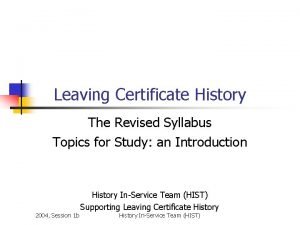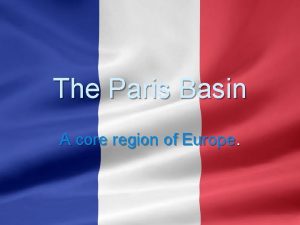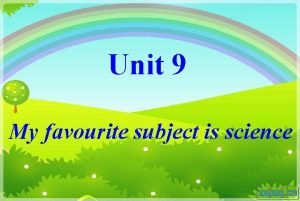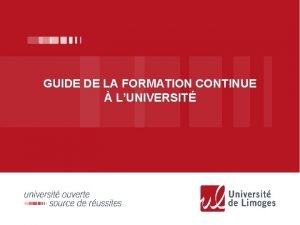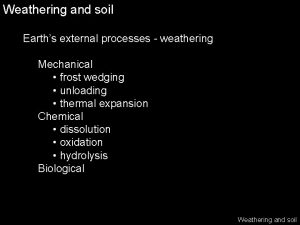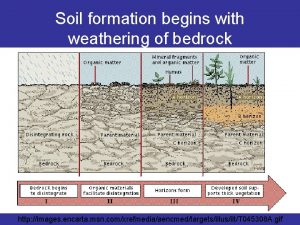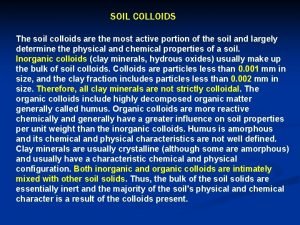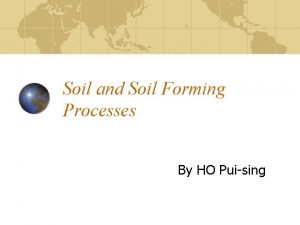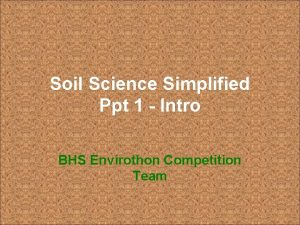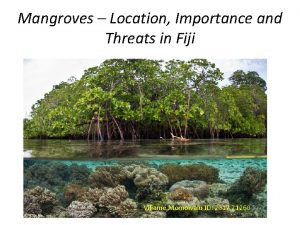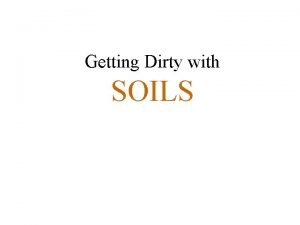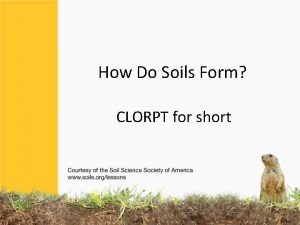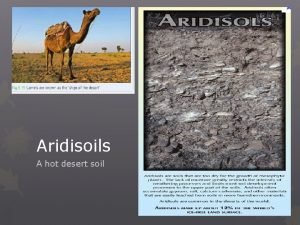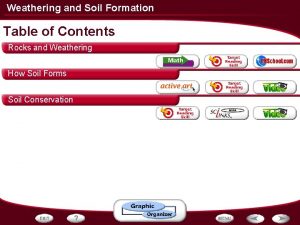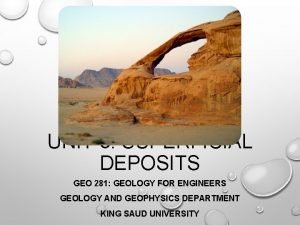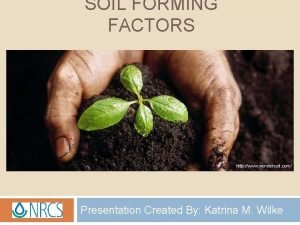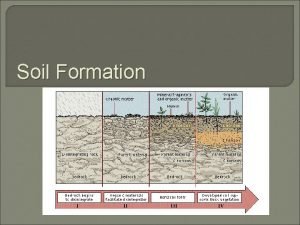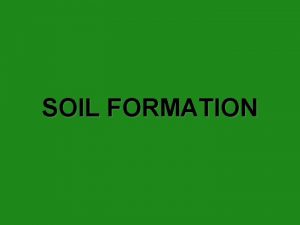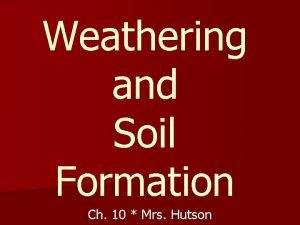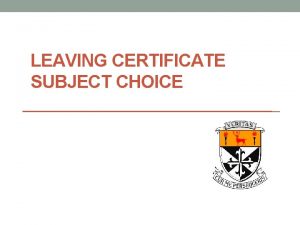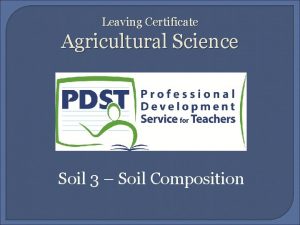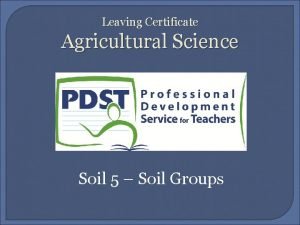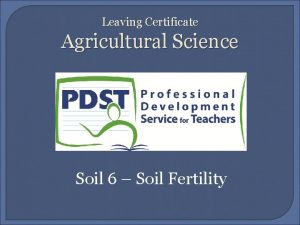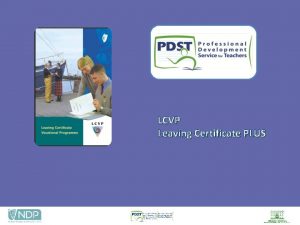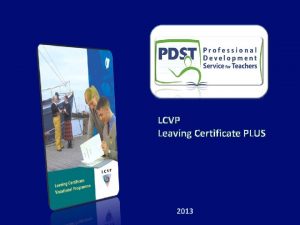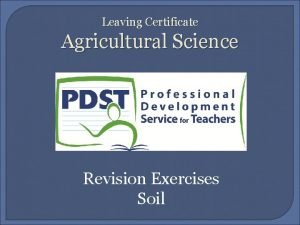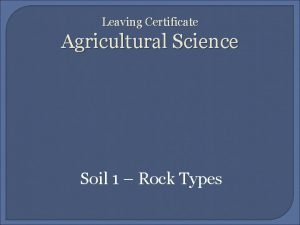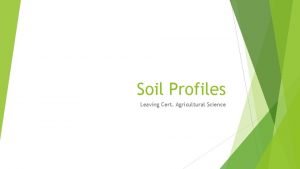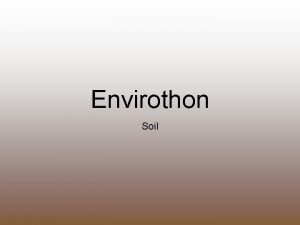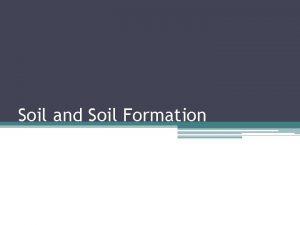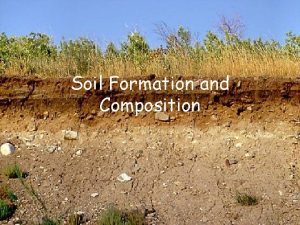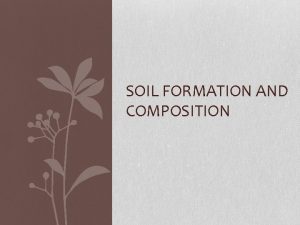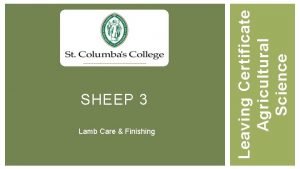Leaving Certificate Agricultural Science Soil 2 Soil Formation






















- Slides: 22

Leaving Certificate Agricultural Science Soil 2 – Soil Formation

Soil Formation � Soil is formed from the weathering of rocks. � Weathering: the breaking down of parent material (rock). � There are 3 types of weathering: • Physical, • Chemical • Biological.

Physical Weathering � The natural forces carry this out: wind, sun, frost, ice. Physical breakdown is caused by the Freeze – Thaw Action phenomenon. • Igneous and Metamorphic rock surfaces absorb heat • • energy from the sun and in doing so they expand. By night as the temperatures drop these rocks contract. Hairline cracks develop. Rain gets into these cracks and when it freezes, it expands up to 9% thus causing the rocks to shatter. The resulting small particles are called Solum.

Physical Weathering

Chemical Weathering � Acid rain and SO 2, CO, NO 3 � Burning fossil fuels e. g. coal, turf, oil, and natural gas produces Sulphur dioxide. If it combines with water it forms Sulphuric acid SO 2 + H 2 O H 2 SO 4 Sulphuric acid CO 2 + H 2 O H 2 CO 3 Carbonic acid NO 3 + H 2 O H 2 NO 3 Nitric acid �

Chemical Weathering � Chemical breakdown occurs when soluble components in the rock are dissolved by water. (A very strong solvent) � This is further emphasised by various types of dissolved acids in rainwater. � Carbonic acid, Nitric acid and Sulphuric Acid are common in rainwater.

Chemical Weathering

Biological Weathering � Early plant life like Lichens can breakdown rocks. � Lichens get minerals from rocks by secreting an acidic liquid into the rocks. � This further breaks down the rocks decays slowly. � When lichens die they also form the first layer of humus (decaying material) that will eventually become the soil. � When the humus becomes a few inches thick, other plants (like grasses and mosses) can begin to grow on it. � The roots of these plants then can break the rock further.

Biological Weathering

Glaciation & Glacial deposit � Glaciation is when snow and ice accumulate in mountain river valleys and move slowly downwards due to gravity. � When glaciers reach lowland areas, they join together and form larger piedmont glaciers. � In turn these large piedmont glaciers join together to form giant ice sheets. � These ice sheets can cover thousands of kms and are moving constantly. � Glaciation has occurred in Ireland in the past and has contributed to Ireland climate and soil. � North Europe is said to be in an inter-glacial period.

Glaciation

Glaciation & Glacial deposit � When glaciers and ice sheets move they scrape all soil and loose rock from the surface. � This material becomes mixed in the lower layers of the ice and are deposited as glacial drift a goof distance away from its original position. � This material then serves as parent rock for soil formation. � Irelands soils are said to be young because they are only 12, 000 years old.


Peat Soils � There are 3 types of peats: Blanket, Basin and Raised peats � � Blanket Peats: • Found in mountainous areas where high rainfall is • • typical (Wicklow, Clare and Kerry to some extent). Blanket bogs are so called because they form a blanket over a wide area. Shallow (1 - 2 meters deep at most). They do not have as much potential for cultivation by large-scale machinery or farming, mainly because where they are located. Soils are wet, acidic and infertile.

Peat

� Basin Peats: • Occurs in land with a depression i. e. a hollow lake or • • river. Dead remain of plants accumulate at the bottom of the lake. The build up of the dead vegation cuases the lake to close over and become land. Occurs in water logged and flooded conditions. Drier and of more agricultural use than blanket bogs


� Raised bogs: • Further development of basin bogs. • They are raised above the level of the surrounding ground.

Formation of the Peat Bogs � After the Ice Age, glaciers left a vast amount of small, shallow lakes around Ireland, these were taken over by vegetation (plants like reeds and sedges) growing from the shore inwards. � Decaying organic matter filled the lake to above the water level, so it is no longer a lake. � Trees such as birch and alder and shrubs then moved in once all the water had gone. � The areas are then referred to as carr or fen (fenn) woods.

Formation of the Peat Bogs These trees would eventually die as well and become part of the decaying mass. � Organic parent material is formed from half decomposed plants under very wet anaerobic soils or in lakes; these conditions prevent the full break down of the plants. � This is referred to as peat parent material and they give rise to peat soils. � The dominant species at this stage are bog mosses (sphagnum mosses). � These bog mosses can soak up five times their weight in water and after thousands of years of Irish weather, these mosses were able to build up to heights of 10 metres above the once lake floor. � These bogs are called Raised bogs and are typical of the midlands. �


 Leaving certificate history syllabus
Leaving certificate history syllabus Primary leaving certificate
Primary leaving certificate Clonakiltycc vsware
Clonakiltycc vsware Formation of sedimentary rocks leaving cert
Formation of sedimentary rocks leaving cert Paris basin map
Paris basin map English science and blank are my favorite subject
English science and blank are my favorite subject Formation initiale vs formation continue
Formation initiale vs formation continue Mechanical and chemical weathering venn diagram
Mechanical and chemical weathering venn diagram Soil formation begins with the weathering of bedrock
Soil formation begins with the weathering of bedrock Types of soil colloids
Types of soil colloids Eluviation and illuviation
Eluviation and illuviation Soil acidity ppt
Soil acidity ppt Soil formation
Soil formation O a b c r
O a b c r How do soils form
How do soils form Desert soil horizons
Desert soil horizons Stages of soil development
Stages of soil development Formation of soil
Formation of soil Soil
Soil Factors of soil formation
Factors of soil formation What is bedrock
What is bedrock Soil textural triangle practice exercises
Soil textural triangle practice exercises Mechanical and chemical weathering venn diagram
Mechanical and chemical weathering venn diagram
